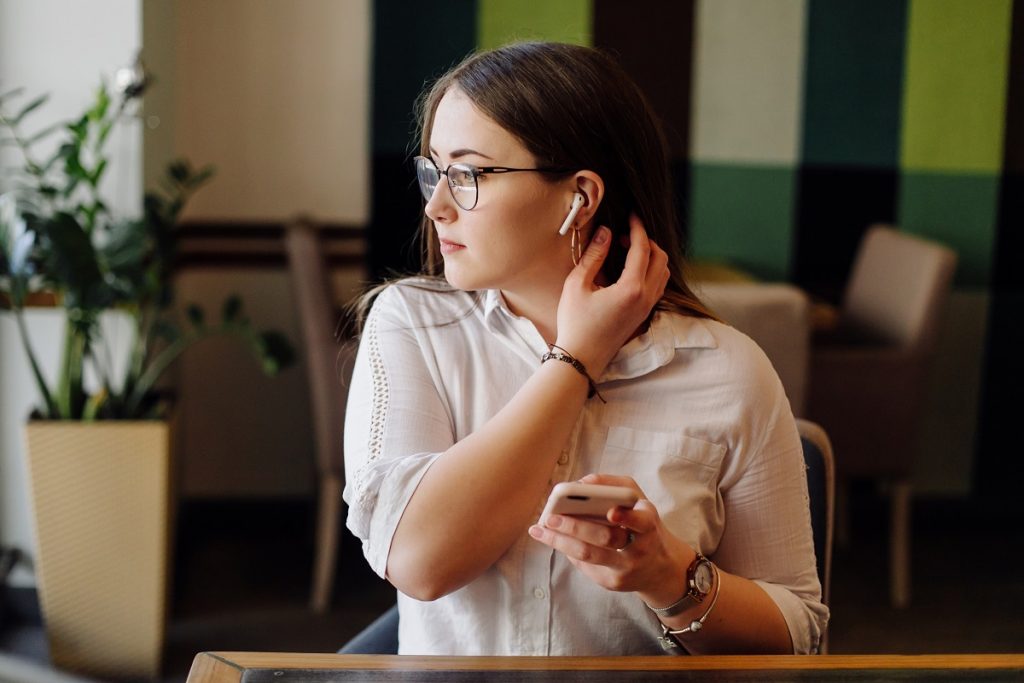- Translation earbuds provide real-time language support – They capture speech, process it digitally, and deliver instant translations, making communication smoother for low vision users.
- Accessibility features make them user-friendly – Voice-guided setup, minimal screen reliance, app compatibility, and customizable audio settings enhance independence.
- Hands-free operation reduces reliance on screens – Compared to smartphone apps, earbuds allow low vision users to engage in conversations without reading text or managing devices visually.
- Device selection matters – Voice-first controls, high-quality audio, automatic language detection, and long battery life improve usability for low vision users.
- Overcoming challenges is possible – Background noise, battery management, language nuances, and connectivity issues can be mitigated with noise-canceling features, tactile cues, and proper preparation.
- Real-life benefits are significant – Translation earbuds improve travel experiences, workplace communication, social interactions, and emergency communication, promoting confidence and independence.
Language barriers are a common hurdle in our globalized society, complicating interactions whether we’re traveling, working, or simply meeting new people. For those with low vision, technology is an impactful solution. Translation earbuds are one such innovation, providing a unique combination of convenience, accessibility, and independence. But precisely how do these devices cater to the needs of people with low vision? Let’s explore.
- What Are Translation Earbuds?
- How Do Translation Earbuds Work?
- Are Translation Earbuds Accessible for People With Low Vision?
- How Do Translation Earbuds Compare to Mobile Apps?
- Which Types of Translation Earbuds Work Best for Low Vision Users?
- Can People With Low Vision Use Translation Earbuds Independently?
- Common Challenges and How to Overcome Them
- How Can Translation Earbuds Improve Everyday Life?
- Tips for Choosing the Right Translation Earbuds
- Are Translation Earbuds Worth It for People With Low Vision?
- Future Innovations in Translation Technology
- How to Maximize Your Experience With Translation Earbuds
- Frequently Asked Questions
- Final Thoughts
What Are Translation Earbuds?
Translation earbuds are small, wireless devices that fit into your ears, just like standard Bluetooth earbuds. You may have wondered, ‘Do translation earbuds work for people with low vision?’ The answer is yes—they are designed to capture spoken language, process it in real time, and translate it into the user’s preferred language.
Key features include:
- Real-time translation – Many models offer instant translations, allowing conversations to flow naturally.
- Wireless connectivity – Most connect via Bluetooth to smartphones or tablets.
- Voice recognition – Built-in microphones detect and differentiate between speakers.
- Language support – Some earbuds support dozens of languages and dialects.
For people with low vision, these features are especially useful because they reduce the need to read screens or text-heavy apps, relying instead on spoken instructions and audio output.
How Do Translation Earbuds Work?

Translation earbuds use a combination of hardware and software to convert spoken language into understandable translations. Here’s a step-by-step breakdown:
- Voice Detection – The earbuds’ microphones capture speech from the surrounding environment.
- Signal Processing – The device converts the audio into digital signals for processing.
- Language Analysis – Advanced algorithms analyze the speech, identifying words, grammar, and context.
- Translation Engine – The digital signal is sent to a translation engine, often cloud-based, which interprets the words in the target language.
- Audio Playback – The translated words are converted back into speech and played through the earbuds in real time.
Some earbuds can even detect multiple speakers at once, translating each voice individually, which is particularly useful in group conversations.
Are Translation Earbuds Accessible for People With Low Vision?
Yes. Modern translation earbuds are designed with accessibility in mind. People with low vision can benefit from:
- Voice-guided setup – Many earbuds walk users through setup using spoken prompts.
- Minimal reliance on screens – Essential functions can often be controlled by voice commands.
- App compatibility – Mobile apps linked to the earbuds are often compatible with screen readers.
- Customizable settings – Users can adjust voice speed, volume, and language preferences without needing to see the screen.
These features make translation earbuds a practical tool for communication without depending heavily on visual cues.
How Do Translation Earbuds Compare to Mobile Apps?
Some people wonder whether they need earbuds or if a smartphone app alone can do the job. Here’s a quick comparison:
Translation Earbuds:
- Hands-free and portable
- Real-time, continuous translation
- Less distraction, especially in social or work settings
Smartphone Apps:
- Often require holding the phone or reading text
- May have slight delays in translation
- Can be less convenient in noisy or crowded environments
For people with low vision, earbuds offer the advantage of reducing screen dependence and providing seamless auditory feedback, making conversations more fluid.
Which Types of Translation Earbuds Work Best for Low Vision Users?

Not all earbuds are created equal. Some models are better suited for people with low vision due to enhanced accessibility features. Look for:
- Voice-first operation – Devices that rely on spoken commands instead of touchscreens.
- High-quality audio – Clear sound ensures that translations are easy to hear and understand.
- Automatic language detection – Some earbuds can detect the spoken language and translate without manual input.
- Long battery life – Extended use is important for travel or long meetings.
Brands such as Google Pixel Buds, Timekettle, and WT2 Plus have models that focus on user-friendly interfaces and real-time translation capabilities, often praised for accessibility.
Can People With Low Vision Use Translation Earbuds Independently?
Absolutely. Many low vision users report being able to manage translation earbuds on their own. Tips for independence include:
- Familiarize with voice commands – Practice the earbuds’ commands for activating translation, switching languages, or adjusting volume.
- Use tactile markers – Apply small raised dots or stickers on the earbuds to help identify buttons by touch.
- Leverage audio prompts – Ensure the earbuds’ settings are configured to give spoken feedback for confirmations.
- Pair with screen readers – Most companion apps support accessibility tools for setup and troubleshooting.
With these adjustments, people with low vision can enjoy conversations in foreign languages with minimal assistance.
Common Challenges and How to Overcome Them
Even the best technology has limitations. Low vision users may face challenges such as:
- Background noise – Some earbuds may misinterpret speech in crowded or noisy areas. Consider models with advanced noise-canceling microphones.
- Battery management – Keeping track of charging can be tricky; using voice reminders or tactile cues can help.
- Language nuances – Idioms, slang, or regional accents can sometimes lead to inaccurate translations. Patience and context are key.
- Connectivity issues – A stable internet connection improves accuracy, as many earbuds rely on cloud processing.
Being aware of these issues and preparing for them can make the translation experience smoother and more reliable.
How Can Translation Earbuds Improve Everyday Life?
Translation earbuds can have a profound impact on daily activities for people with low vision:
- Travel – Ordering food, asking for directions, and interacting with locals becomes easier and more confident.
- Workplace communication – In multilingual offices, earbuds help participate in meetings without constantly relying on visual aids.
- Social interactions – Conversations with international friends or neighbors are more inclusive and natural.
- Emergency situations – When immediate communication is needed, translation earbuds provide quick understanding.
The ability to engage independently reduces stress and opens opportunities that might otherwise require assistance.
Tips for Choosing the Right Translation Earbuds
Here’s what to consider before investing in translation earbuds:
- Language coverage – Make sure the languages you need are supported.
- Accuracy – Look for devices with strong reviews on translation fidelity.
- Battery life – Longer battery life is crucial for travel or all-day use.
- Accessibility features – Voice commands, audio feedback, and compatibility with assistive apps matter for low vision users.
- Comfort and fit – Earbuds should be comfortable for extended wear.
Testing a few options, reading accessibility-focused reviews, and checking app support can help you find the best fit.
Are Translation Earbuds Worth It for People With Low Vision?
For many low vision users, the answer is yes. They offer a unique combination of convenience, independence, and accessibility. While there are challenges—like any tech—modern translation earbuds have come a long way in creating inclusive experiences.
Some benefits to consider:
- Hands-free communication – Eliminates the need to read text or screens.
- Confidence in social settings – Reduces anxiety when navigating multilingual environments.
- Learning opportunities – Hearing real-time translations helps improve language understanding.
- Practicality – Compact, portable, and often compatible with multiple devices.
While not a replacement for professional interpreters in complex situations, translation earbuds are ideal for everyday interactions and casual conversation.
Future Innovations in Translation Technology
The technology behind translation earbuds is evolving rapidly. Here’s what low vision users can look forward to:
- Improved offline functionality – Translation without relying on internet connections.
- Enhanced AI translation – Smarter context understanding and more accurate phrasing.
- Integration with smart home devices – Earbuds could connect with home assistants for multitasking.
- Voice personalization – Natural-sounding translations tailored to the user’s preferences.
As these devices advance, they will become even more accessible, efficient, and user-friendly for people with low vision.
How to Maximize Your Experience With Translation Earbuds
Here are practical tips for getting the most out of your earbuds:
- Keep software updated – Updates often improve translation accuracy and add accessibility features.
- Practice with friends or family – Familiarity helps increase confidence.
- Learn basic phrases in multiple languages – Even partial knowledge can complement translation and reduce errors.
- Maintain earbuds carefully – Regular cleaning ensures microphones pick up speech clearly.
- Test in different environments – Understanding how earbuds handle background noise or group conversations helps optimize use.
These small steps can make the earbuds a more effective tool in real life.
Frequently Asked Questions
Q: Can translation earbuds translate multiple languages at once?
A: Some models can switch between languages on the fly, but simultaneous multi-language translation is limited to advanced models.
Q: Do I need internet access for translation earbuds?
A: Many models rely on cloud-based translation, so internet access improves accuracy. Some earbuds offer offline modes with limited functionality.
Q: Are translation earbuds comfortable for all-day use?
A: Comfort depends on the model and fit. Look for lightweight designs with different ear tip sizes for long-term wear.
Q: Will translation earbuds work in noisy environments?
A: Noise-canceling microphones help, but extremely loud settings may affect accuracy. Some earbuds allow you to adjust sensitivity to reduce errors.
Q: Are they affordable for most users?
A: Prices range widely, from budget options under $50 to high-end models over $300. For accessibility-focused features, mid-range models often offer the best balance.
Final Thoughts
Translation earbuds are transforming how people communicate, especially for those with low vision. They provide independence, convenience, and an inclusive way to navigate multilingual environments. By choosing the right model, familiarizing yourself with its features, and taking advantage of accessibility options, translation earbuds can become a reliable companion for everyday life.
From travel to work and social settings, these devices make conversations more accessible and enjoyable. As technology continues to evolve, their potential to improve communication for low vision users will only grow, bridging language barriers in ways that were once impossible.





